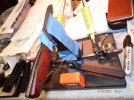today i realized that i have a total of 5 sickles not 4 not 3, i wasn't aware! since 4 of them look alike (same SKU), to me it feels like i resharpen the same old unit over and over again haha:

As this scythe5 is very rusty, there's some chance that it wasn't featured here before. however, i can tell right away that i must have sharpened it before. never mind.

The edge had nicks, chips, dings, broken off apex parts, and wouldn't catch/bite in the paper cut test. The corrosion ("rusted apex") contributed to the dullness too, no doubt. Since the edges of the other 4 sickles deformed too easily upon cutting impact —they were not thick enough "behind the edge" and lacked the OOTB coarse edge-leading grind structural stability (toothiness)— , this time i was okay with grinding a 1mm-wide polished secondary bevel. Too wide to be called "microbevel", let's call it "minibevel". I did 3 stages, each came with burr creation and burr removal: stage1) diamond file for 75min, stage2) my finest retractable ruby for 20min, and optional stage3) retractable Spyderco for 15min:

Most of the time i did edge-following movements with the rods, not edge-leading, not edge-trailing, because edge-following movements come most natural when sharpening a sickle with such small cylindrical rods (but, as we know, future edge stability will suffer from such a sharpening method because ideally you'd rather want coarse grind lines perpendicular (and not parallel) to the apex line, as seen OOTB).
Grinding a minibevel at an obtuser apex angle is also the easiest way to get rid of the unevenness of the apex line (nicks, chips, dings, etc). Now i am hoping for improved edge stability thanks to the minibevel, we'll see how the edge holds up.

As this scythe5 is very rusty, there's some chance that it wasn't featured here before. however, i can tell right away that i must have sharpened it before. never mind.

The edge had nicks, chips, dings, broken off apex parts, and wouldn't catch/bite in the paper cut test. The corrosion ("rusted apex") contributed to the dullness too, no doubt. Since the edges of the other 4 sickles deformed too easily upon cutting impact —they were not thick enough "behind the edge" and lacked the OOTB coarse edge-leading grind structural stability (toothiness)— , this time i was okay with grinding a 1mm-wide polished secondary bevel. Too wide to be called "microbevel", let's call it "minibevel". I did 3 stages, each came with burr creation and burr removal: stage1) diamond file for 75min, stage2) my finest retractable ruby for 20min, and optional stage3) retractable Spyderco for 15min:

Most of the time i did edge-following movements with the rods, not edge-leading, not edge-trailing, because edge-following movements come most natural when sharpening a sickle with such small cylindrical rods (but, as we know, future edge stability will suffer from such a sharpening method because ideally you'd rather want coarse grind lines perpendicular (and not parallel) to the apex line, as seen OOTB).
Grinding a minibevel at an obtuser apex angle is also the easiest way to get rid of the unevenness of the apex line (nicks, chips, dings, etc). Now i am hoping for improved edge stability thanks to the minibevel, we'll see how the edge holds up.
Last edited:








